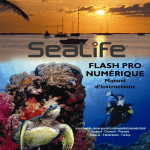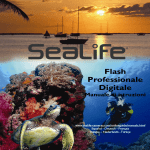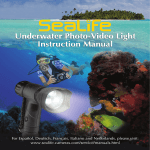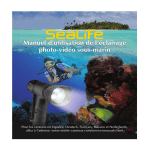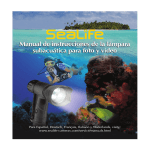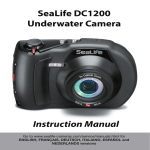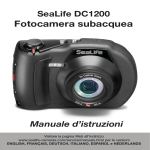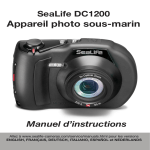Download Sealife SL962 Instruction manual
Transcript
DIGITAL PRO FLASH Instruction Manual http://www.sealife-cameras.com/service/manuals.html Español - Deutsch - Français Italiano - Nederlands - Türkçe Contents: I. Safety Warnings...........................................................3 II. Introduction ................................................................4 III. Preparing your camera ................................................5 IV. Preparing your flash ....................................................6 V. Testing your camera and flash ...................................21 VI. How to adjust your camera and flash........................22 VII. Maintaining a waterproof seal ...................................28 VIII. Pre-dive checklist ......................................................30 IX. After each dive ..........................................................31 X. Care and maintenance ..............................................31 XI. Great pictures made easy ..........................................32 XII. Troubleshooting Guide..........................................35 XIII. Specifications .......................................................38 XIV. Parts and service...................................................39 http://www.sealife-cameras.com/service/manuals.html Español - Deutsch - Français - Italiano - Nederlands - Türkçe 2 I. Safety Warnings Always discharge flash before opening the waterproof door, by moving the power switch to the “TEST” position, and then to the “OFF” position. This will discharge the high-voltage electricity stored in the flash. If foreign objects or water has entered the flash, discharge and turn off flash. Continued use in this state may cause fire or electrical shock. Contact the SeaLife service center for repairs. Do not attempt to access the electronic circuitry for any reason. The internal electronics uses high-voltage components that may result in severe electrical shock. The On/Off/Test switch contains a powerful magnet. Keep away from compasses and electronics to avoid magnetic interference. Do not expose flash to heat or direct sunlight for prolonged periods of time. Observe all SCUBA dive safety rules and control your buoyancy at all times. Consult your dive instructor for dive safety questions. Visit www.sealife-cameras.com for updates to this manual and techniques on underwater photography. Check out the online guide called Great Pictures Made Easy. 3 II. Introduction Thank you for purchasing the SeaLife Digital Pro Flash. Novice and experienced divers alike know that the deeper you dive, less light penetrates the water. While this descending drama adds to your excitement as a diver, you will find that it also challenges you as an underwater digital photographer. The water filters out red and yellow so everything looks blue. The fact is that reefs and fish are bursting with color. A powerful underwater flash system is the best way to restore the lost colors. Without Digital Flash With Digital Flash This instruction manual will guide you through all the essential information on how to operate and care for your flash, and tips on capturing some of the best underwater pictures of your life. 4 III. Preparing your camera Become familiar with how to operate your camera. Refer to your camera instruction manual for information on how to adjust the settings described in this manual. Here is the basic camera set-up for SeaLife and most other popular digital cameras and their housings. 1. Insert blank memory card. It’s good practice to regularly format memory card, but be careful, because this will erase all images on the card. 2. Make sure your camera battery(ies) are new or freshly charged before each dive. 3. Set SeaLife digital cameras to External Flash mode 4. For Non-SeaLife camera’s, do this: a. Set ISO to 100 (or less if available) but not Auto. b. Set White Balance to “CLOUDY” for better color. c. Set camera’s flash to FORCE ON. d. Select the highest image resolution. e. Some camera offer manual shutter and aperture controls, which is recommended for advanced photographers only. 5. Inspect and clean camera housing and main O-ring in accordance with the camera/housing instructions. 6. Insert camera and seal the housing. 7. Take a test picture to make sure the camera’s flash fires. 5 IV. Preparing your flash Unlock the latch by sliding down the safety lock. Lift the latch and open the waterproof door to access the battery compartment, pre-flash setting, and auto mode setting. Important: • Make sure the flash and you are perfectly dry before opening the waterproof door. • Open the waterproof door with the door pointing down, so any water trapped around the o-ring does not drip inside the flash. 6 Insert 4 new or freshly charged AA batteries. Open the battery compartment cover and insert batteries according to the polarity markings above the battery compartment. 7 Set the Pre Flash switch to the “0” position for all SeaLife cameras. For non-SeaLife digital cameras, set switch to the #4 position to start. More information about finalizing the Pre-Flash setting for NON-SeaLife cameras is provided on page 19 of this manual. Pre Flash Switch What is a Pre-flash? Most digital cameras have one or more pre-flashes to assist in autofocus/auto-exposure setting of the camera. The Pre-Flashes occur before the camera’s primary flash fires. The Pre-Flash Setting switch tells the external flash how many pre-flashes to ignore before firing. For example, if your digital camera has 2 pre-flashes, you would set the Pre-Flash Setting switch to 2. The external flash will now ignore the two pre-flashes and fire on the third primary flash. SeaLife cameras do not have a pre-flash when the camera is in External Flash mode. More information on how to make the correct pre-flash setting for your non-SeaLife cameras is described on page 19 of this manual. 8 Pre-flash cancellation settings (continued): Switch position 0 Description of setting Cameras with no pre-flash For all SeaLife cameras [Camera set to Ext Flash mode] 1 Camera with 1 pre-flash [and cameras with rapid-fire pre-flash*] 2 Camera with 2 pre-flash 3 Camera with 3 pre-flash 4 Camera with 4 pre-flash *Note: The #1 pre-flash setting works with cameras that use 1 pre-flash or a rapid-fire pre-flash system because it has a built-in 50 millisecond delay between the first pre-flash and the primary flash. More information on how to calibrate the pre-flash setting for your non-SeaLife cameras is described on page 19 of this manual. 9 Set the Auto mode switch to the “1” position for all SeaLife cameras and “4” position for all Non-SeaLife digital and film camera’s. More information about the Auto mode setting for your NON-SeaLife camera is provided on page 20 of this manual. Auto Mode Switch What is the Auto mode? Auto mode will automatically control the brightness of the external flash and help you to achieve optimal image exposure. When the external flash fires the light sensor located in the front of the flash will instantly measure the light reflecting from the subject. If it senses too much light, it will quickly stop the flash and prevent the image from being over-exposed. There are 4 possible Auto mode settings. settings. One of the four settings will be best depending on your camera type. The #1 setting will result in slightly less powerful flash brightness and #4 will result in a more powerful flash brightness. More information on how to calibrate the Auto mode setting for your non-SeaLife camera is described on page 20 of this manual. 10 Close and seal the waterproof door. Make sure the O-ring is perfectly clean and undamaged. Carefully close the waterproof door to make sure nothing gets trapped near the o-ring and make sure o-ring slips into position and does not get pinched. Make sure the waterproof door is completely closed. Lock the latch by sliding the safety lock upwards. Important: Refer to Maintaining a Waterproof Seal in section VII of this manual on how to inspect the O-ring for cuts, tears, dirt or other damage. Clean or replace as necessary. Do not grease O-ring. Wipe the O-ring and contact surfaces with a damp cotton cloth to clean. Never stretch the O-ring. 11 Attach camera (housing) to the flash’s mounting base. Carefully hand-tighten the mounting screw. Do not over tighten! Important: Only attach the flash to cameras/housings with minimum thread depth of 0.250” (6.4mm) and using standard 1⁄4-20 tripod type thread. Never force or over-tighten the screw, or you may damage the housing seal and threads. 12 Attaching camera/housing to two flashes. You can easily add up to two flashes to your underwater camera. Using dual flashes helps avoid shadows and will further intensify brightness and color. Remove the smaller mounting screw (0.625” / 15.9mm, item #SL96025) from each flash unit. Attach the larger mounting screw (1” / 25.4mm, item #SL96022 - not included) through both flash mounting trays and into the camera housing. Rotate each flash head so they are aiming in the forward direction as shown. Note: A longer mounting screw (Item #SL96022) is required when mounting two flash units. Contact your local SeaLife dealer or www.sealifepartsdirect.com to order a longer screw. 13 Connecting Flash Link optical cable to the external flash The Digital Pro Flash includes the Flash Link optical cable (item #SL962). The optical cable is used to transmit the light from the camera to the light sensor under the external flash head. The external flash will fire when the light sensor detects light coming from the end of the cable. The external flash should come with the optical cable already attached to the flash head, but it is good to know how the cable can be removed and attached. 1. 2. 3. 1. Turn the cable locking screw counter-clockwise by about 2 rotations to loosen the clamping effect of the lock. Do not remove the locking screws. 2. Insert the optical cable into the hole of the cable lock until the cable stops [make sure cable is pushed up all the way]. 3. Turn the cable locking screw clockwise to lock the cable into place [finger tight only – Do not over tighten]. 14 Connecting Flash Link optical cable to SeaLife cameras For SeaLife cameras: Attach the other end of the optical cable to the camera adapter included with your SeaLife camera. The following example shows the optical cable being connected to the SeaLife DC800/DC1000 camera adapter. 1. 2. 3. 1. Push the optical cable into one of the grooves so it’s locked firmly into position. The end of the cable must be directed at the camera’s flash but should not stick out beyond the adapter. The adapter has two grooves, so you can add another cable when using two flashes. 2. Attach the Flash Link adapter around the lens and push down until it locks firmly into place. There are two small locking mechanisms located on the outer edge of the adapter that should lock in to the camera housing. Make sure the adapter is oriented so it is aligned with the recessed flash window. 3. Once the cable and adapter is firmly attached, run the cables along the bottom of the flash base and up the flash arm. The cables should be secured to the flash arm using the Velcro ties provided with your flash accessory. 15 Connecting Flash Link optical cable to NON-Sealife cameras For NON-SeaLife cameras: Attach the other end of the optical cable to the universal camera adapter provided as shown below. 1. 2. 1. Remove the tape backing of the hook-and-loop tape provided. 2. Stick the tape over the flash window of your camera housing. 16 Connecting Flash Link optical cable to NON-SeaLife cameras (continued) 3. 4. 5. 3. Loosen the set screw of the universal adapter with the small Allen wrench provided. 4. Insert the optical cable into the hole as shown above and push the cable as far as possible without the cable sticking out on the other side of the adapter. 5. Carefully tighten the set screw until 6. you feel it makes contact with the cable then give it another 1⁄4 turn. Gently pull at the cable to make sure it is secure. Do not over tighten the set screw or you will damage the optical cable. 6. Press the cable adapter onto the housing as shown above. 17 Secure the Flash Link optical cable to the flash arm Use the two Velcro ties provided to secure the optical cable to the top and bottom of the flash arm. 18 Finalize Pre-Flash setting for non-SeaLife digital cameras Follow these steps to determine the correct Pre-Flash setting for your non-SeaLife camera: 1. Set the pre-flash setting to #4. 2. Power on the camera and flash. a. Make sure the camera settings are set as described in section III of this manual. b. Turn the flash brightness power knob on the back of the flash to 9 or 10 position. (Not Auto position) 3. Wait for the red flash-ready light to turn on. 4. Take a test picture of an object about 3ft/1m shooting distance. 5. Review the picture on your camera. 6. Is the picture dark or very bright (possibly overexposed)? a. If the picture is a dark picture, move the pre-flash setting switch down by one (For example, from #4 to #3) and repeat steps 3 to 6. b. If the picture is bright (possibly overexposed) the preflash setting is correct. You have now finalized your preflash setting. Note: Once you have determined the correct pre-flash setting for your camera, you should not have to change it again. This will become your permanent pre-flash setting unless you change cameras. 19 Finalize Auto mode setting for non-SeaLife digital cameras Follow these steps to determine the correct Auto mode setting for your camera: 1. Set the Auto mode setting to #4. 2. Power on the camera and flash. a. Make sure the camera settings are set as described in section III of this manual. b. Turn the flash brightness power knob on the back of the flash to the for Auto. (All the way counter-clockwise) 3. Wait for the red flash-ready light to turn on. 4. In a dimly lit room, take a test picture of a flat non-reflective object (like a painting on the wall) at about 5ft/1.5m shooting distance. 5. Move the Auto mode setting switch down by one (For example, from #4 to #3) and repeat steps 3 to 5 until you have taken 4 pictures, one picture for each setting. 6. Review the pictures on your camera or computer and determine which of the 4 pictures have the best color and exposure. 7. Set the Auto mode switch to the position which matches the best picture taken in the above test. For example, if the second picture is the best of all four pictures, set the Auto mode switch to #3. 8. You have now finalized the Auto mode setting. Note: Once you have determined the correct Auto mode setting for your camera, you should not have to change it again unless you change cameras. Most SeaLife cameras will perform best in the #1 position). 20 V. Test the camera and flash [above water] Now that you have made all the correct settings to your flash and camera, take a few more test pictures to make sure the camera and external flash fires together. 1. Power on the camera and flash. a. Make sure the camera settings are set as described in section III of this manual. b. Turn the flash brightness power knob on the back of the flash to the for Auto. 2. Wait for the red flash-ready light to turn on. 3. Take a series of test picture while viewing the external flash at an angle (Don’t look directly into the flash). 4. The camera’s flash and the external flash should be firing together. 5. If the external flash is not firing at the same time as the camera’s primary flash review the instructions on the previous page or refer to the trouble shooting guide at the end of this manual. 21 VI. Adjusting your camera exposure and flash brightness This section will show you to make quick and easy adjustments to your camera and flash for achieving the best picture color and brightness. Make sure you become familiar with these basic adjustments before you dive with your new external flash. Overexposed picture Contrast and Colors are washed out Properly exposed picture Good contrast with vibrant colors. You can adjust your camera setting and/or external flash settings to achieve the best image exposure and color. 22 Camera adjustments: First, let’s learn about the different types of camera adjustments you can make. Scene modes Most digital cameras offer a variety of “Scene” modes which presets the camera’s controls depending on the type of picture you want to take. For SeaLife digital cameras, set the scene mode to Ext Flash (or Ext Flash Auto mode). For information on how to set your SeaLife camera’s scene mode, please refer to your SeaLife camera instruction manual. For non-SeaLife cameras, we recommend starting with AUTO scene mode. If your non-SeaLife camera has an “underwater” scene mode, don’t use it. These “underwater” modes are not intended for cameras using an external flash. Read your camera’s instruction manual to learn more about your camera’s scene modes. Experiment to find the best setting for you. ISO setting The term ISO (International Standards Organization) relates to the ability (or “speed”) of the camera’s sensor to accept light. The higher the ISO value, the more sensitive the camera is to light, resulting in a brighter but more grainy image. For SeaLife cameras, set the camera to Ext Flash mode (or Ext Flash Auto mode) and leave the ISO on Auto. Your SeaLife camera 23 is pre-programmed to automatically select the optimal ISO value for underwater flash pictures. For non-SeaLife cameras, select a lower ISO, like 50 or 100, because the picture will be sharper and less grainy. EV Compensation Your camera’s EV (Exposure Value) Compensation setting works very much like the ISO setting - Increase EV value to brighten images, and decrease EV value to darken pictures. Just like ISO, higher EV values will result in more grainy pictures. For SeaLife cameras, set the camera to Ext Flash mode (or Ext Flash Auto mode) and leave the EV Compensation at “0”. Your SeaLife camera is pre-programmed to automatically select the optimal EV value for underwater flash pictures. For non-SeaLife cameras, start with an EV value setting of -2 and make adjustments as necessary to achieve the best results. Avoid using + EV values. White Balance The camera’s White balance setting will match your camera’s image sensor to the color “temperature” of the primary light source. For SeaLife cameras, set the camera to Ext Flash mode and leave the White Balance on Auto. Your SeaLife camera is preprogrammed to match the color temperature of the flash. For non-SeaLife cameras, it is recommended to select the CLOUDY White Balance setting. 24 Camera’s flash setting Almost all digital cameras allow you to select the flash setting to Auto, Force ON, Force OFF or Red-Eye Reduction. For SeaLife cameras, set the camera to Ext Flash mode (or Ext Flash Auto mode). The SeaLife External Flash mode is a special underwater program that synchronizes the camera's exposure program, color balance and internal flash to the Digital Pro Flash. The camera's flash will always fire in Ext Flash mode. For non-SeaLife cameras, select FORCE ON. Remember, your external flash will only fire if your camera’s flash fires. Manual exposure controls Some digital cameras include manual aperture and shutter speed controls, which requires advanced knowledge of photography principles. These controls are too advanced for this instruction manual. For SeaLife cameras, set the camera to Ext Flash mode (or Ext Flash Auto mode). The camera will automatically select the best aperture and shutter speed setting for underwater flash photography. Some SeaLife cameras include Ext Flash Manual mode. Please refer to the camera instruction manual for more details. For non-SeaLife cameras with manual exposure controls, you may want to take an underwater photography course to learn more about using manual controls. 25 External Flash adjustments: Now that you are familiar with camera adjustments that effect picture color and brightness, this section will describe how to adjust the external flash. Flash Brightness control You can manually or automatically control the external flash brightness by adjusting the brightness control knob located on the backside of the flash head. Take some test pictures and experiment with the effect of the brightness control. If the test image is over exposed (white or washed out colors), turn the power adjustment 1 or 2 bars clockwise to reduce the flash brightness and take another picture. Do this until the image exposure satisfactory. If the test image is under exposed (dark), turn the power adjustment 1 or 2 bars counter clockwise to increase the flash brightness and take another picture. Do this until the image exposure is satisfactory. Remember that the flash will only reach about 6 ft to 8ft (1.8m to 2.4m) depending on water visibility, so make sure to keep your underwater shooting distance within that range. If you turn the brightness control all the way counter clockwise, to the position, the flash will be set to Auto mode, and automatically adjust the flash brightness. 26 Aiming the external flash The flexible flash arm is fully adjustable to allow quick and easy aiming of the flash. Make sure the flash head is directed at the subject before taking a picture. If the flash is not aimed correctly the image may appear underexposed (darker). Remember that subjects appear closer underwater than they do on land, so direct the flash a little over the intended target to compensate for this underwater effect. Note: The flexible arm consists of seven 1-inch (2.5cm) links covered by foam rubber sleeve. You can bend the flexible arm in any direction, but if you force it beyond the point of resistance, the links will separate. If the links separate, you can reconnect it by pushing the links together until they snap in. Using two external flashes Adding a second external flash will allow you to illuminate the subject on both sides and prevent shadowing. You will follow all the same operating instructions when using two flashes. Please refer to page 13 of this manual for information on how to add a second flash. For more tips and techniques on underwater photography, visit www.sealife-cameras.com and check out the online guide called Great Pictures Made Easy. 27 VII. Maintaining a waterproof seal The flash uses a silicone o-ring and gasket to maintain a waterproof seal. The o-ring is the primary waterproof seal while the gasket helps prevent sand and debris from reaching the o-ring. Every flash is depth tested to ensure a waterproof seal. It is your responsibility to regularly inspect the o-ring and sealing surfaces and maintain this waterproof seal. Always perform these inspection procedures before using underwater. Remove, Clean and Install the O-ring & Gasket Removing the O-ring and Gasket 1. Grab white cable adapter and pull up to unplug the cable from the flash. Do NOT pull on the wire. 2. Remove gasket with your fingers. 3. Remove O-ring with your fingers Important: Do NOT use tools or sharp objects or you may damage the O-ring or Gasket. 28 Inspecting and Cleaning the O-ring, Gasket and contact surfaces 1. Carefully inspect the O-ring and Gasket for cuts(A), tears(B). Replace O-ring and Gasket if damaged. 2. Carefully inspect O-ring contact surfaces and groove for scratches or other damage. It is normal to see molding “seams” near the hinge and latch area. Contact the SeaLife service center in your country if the contact surfaces or groove are damaged. 3. Use a moist, clean cotton cloth to remove hair (C), sand (D), and other debris from O-ring, Gasket, O-ring groove and contact surfaces. Never stretch the O-ring or Gasket. Installing the O-ring and Gasket 1. Install clean O-ring into groove. Be careful not to twist O-ring. 2. Install clean Gasket, making sure it is completely seated against the waterproof door. The grooved side of the Gasket should sit flat against the waterproof door. 3. Plug the cable adapter into the flash. Do NOT use force. Check that the white cable adapter is correctly oriented with the plug. Important 1. Do not lubricate the O-ring or Gasket. 2. Do not exceed operating depth of 200ft/60m. 3. Do not open waterproof door in wet environment. You and the 29 flash must be dry before opening the waterproof door. 4. Do not expose flash to direct sunlight for prolonged periods of time. 5. SeaLife recommends replacing the O-ring and Gasket every year. 6. The O-ring and Gasket set (SL96114) is available at your local authorized SeaLife dealer or online at www.sealifepartsdirect.com. VIII. Pre-dive check list 1. Insert new or freshly charged batteries into your camera and flash. 2. Check that the camera and flash settings are correct and that the Flash Link optical cable is securely attached. 3. Inspect the o-ring and clean off any dirt, sand or debris. Carefully close the waterproof door making sure nothing is trapped in the sealing area and the o-ring slips into position. 4. Take a test picture to ensure the camera’s flash and external flash fire. Remember to power off the camera and flash to preserve battery power. 5. Perform a quick waterproof test before you enter the water – Hold the camera and flash underwater. If you see a steady, continuous-stream of bubbles coming from the camera or flash sealing area remove the camera and flash from the water. Dry off the camera and flash and inspect for any leaks. Note: It is normal that some air bubbles will come from the flash arm and any other air pockets. Most dive boats with have a tub of fresh water intended for underwater cameras. 6. Do not jump in the water with the camera in hand. Ask someone to hand you the camera after you enter the water. 30 IX. After each dive 1. After your dive and before entering the dive boat, hand the camera to someone on the boat. 2. Soak the sealed flash and camera in fresh water to remove salt, sand and dirt. Most boats have a fresh water tub intended for underwater cameras. Never allow the saltwater to dry on the camera or flash. 3. After the camera and flash have been rinsed off, let the water drain out of the flash arm (which has small drainage holes at the bottom) and dry the sealed camera and flash with a towel. 4. Make sure flash (and you) are dry before opening the waterproof door. If you can wait, keep your camera and flash sealed until you are in a dry location. IMPORTANT: When opening the waterproof door, make sure to hold the flash with the door facing down. This will prevent water drops from entering the inside of the flash. X. Care and Maintenance 1. Remove batteries before storing the flash. 2. Allow flash to thoroughly dry before storage. 3. Never use any detergents, cleaners, solvents or chemicals to clean the flash. 4. Insert fresh Moisture-Muncher capsules (item #SL911) inside the battery compartment during storage. This will keep the inside dry and free of corrosion or mildew during storage. 5. Routinely inspect the flash for any worn or damaged parts. Contact your local dive shop, or the SeaLife website for available replacement parts. 31 XI. Great pictures made easy There are plenty of challenges that photographers face in the underwater world. Please take some time to review SeaLife’s online guide called Great Pictures Made Easy by visiting www.sealife-cameras.com. The guide is located under the Technical Support menu. The following information summarizes the basic principles of underwater photography. 1. Crystal clear water Clear water is essential for good underwater pictures. Fine particles suspended in the water, like algae and sediments, cause low visibility and small spots to appear in your picture, commonly referred to as “backscatter”. Your external flash will help you reduce the backscatter effect because the flash only illuminates the outer rim of the floating debris. As a general rule, limit your shooting distance to 1/10 of the water visibility. 2. Limit your shooting distance to 6 ft (1.8m) Water is 800 times denser than air and quickly absorbs light. Your external flash has a limited reach of 6ft (1.8m) to 8ft (2.4m) depending on water visibility. Keep your shooting distance inside of 6 ft (1.8m). 4 ft (1.2m) is ideal. Consider the SeaLife Wide Angle Lens accessory which allows to keep a closer shooting distance and fit everything into the picture. 32 3. Move calmly and control your buoyancy Control your buoyancy at all times and set yourself up in the ideal position before taking a picture. This allows you to hold the camera steady and control your shooting distance. Good buoyancy control will help you avoid stirring up the sandy bottom which will cloud-up the water and cause backscatter. Controlling your buoyancy is very important for your diving safety so don’t take a picture until your buoyancy is under control. 4. Practice and experiment with your camera and external flash controls There is no better way to learn than from your mistakes. Become familiar with your camera controls so you can make quick adjustments depending on the conditions. Take the time to practice and experiment with different settings. Review your pictures and learn from your mistakes. 5. Learn how to compose a good picture Once you have mastered how to control the brightness level (exposure) of your picture, you will want to improve how to set-up a good picture. Here are some basic tips: a. Avoid shooting down on the subject from above. Shooting down usually results in a poor contrast because the subject blends into the background. If possible, shoot upwards from below the subject so you get a blue water background and better contrast. 33 b. Get the entire subject into your picture frame. Don’t cutoff the hands, fins or head of your subject. You can always crop you image later on your computer if you want. c. Learn the compositional rule of thirds. The rule states that an image can be divided into nine equal parts by two equally-spaced horizontal lines and two equallyspaced vertical lines. The four points formed by the intersections of these lines can be used to align features in the photograph. Professional photographers claim that aligning a picture with these points creates more energy and interest in the photo than simply centering the subject. 6. Always observe dive safety rules Do not let photography distract you from diving safely. 34 XII. Troubleshooting Guide 1. Digital Pro Flash does not fire when switch is turned from “ON” to “TEST.” a. Wait until the red flash-ready light is on. If ready light does not turn on, check batteries are inserted correctly. b. Test or replace batteries, if necessary. If 1 of the 4 batteries is not charged or damaged, the read-light may turn on, but the flash won't. Replace all 4 batteries. c. If above does not correct the problem, contact your local SeaLife dealer or SeaLife Service Center in your country. For a list of dealers, please visit www.sealife-cameras.com. 2. Digital Pro Flash fires as tested above, but does not fire when triggered by camera. a. Make sure the power switch is set to “ON” position and the red flash-ready light is on. b. Take a test pictures and make sure your camera’s inner flash fires. c. Check that your camera settings are correct. i. For SeaLife digital cameras, set to External Flash mode. Make sure camera’s ready-light is on. ii. For other camera brands, set camera to Flash ON. Make sure the camera’s flash setting is not set to Auto or Red-Eye reduction. Refer to your camera instructions for problems related to the camera. d. Make sure the flash pre-flash setting switch is properly set in accordance with the instructions provided in this manual. 35 e. Check that the Flash Link optical cable is attached correctly in accordance with the instructions provided in this manual. 3. Flash fires sometimes but not all the time. a. This is normally caused by a damaged Flash Link optical cable or if the optical cable is not set-up correctly. Inspect the optical cable for damage and make sure the cable is attached and secured in accordance with the instructions provided in this manual. b. Check that your camera settings are correct. i. For SeaLife digital cameras, set to External Flash mode. Make sure camera’s ready-light is on. ii. For other camera brands, set camera to Flash ON. Make sure the camera’s flash setting is not set to Auto or Red-Eye reduction. Refer to your camera instructions for problems related to the camera. 4. The recycle time is very long. a. This is normally the result of low battery power. The flash recycle time should not be more than 7 to 8 seconds when the flash is set to full power. b. Replace or recharge batteries if the recycle time is longer than 10 seconds. 36 5. Dark areas in your pictures. a. This is mostly likely caused by not aiming the flash at the subject or if the flash is somehow obstructed. b. Areas further away from the camera will appear darker than closer objects. Maximum shooting distance is 6ft/1.8m to 8ft/2.4m depending on water visibility and the reflectivity of your subject. c. Check the brightness control setting. Turn counterclockwise to increase flash brightness. Turn clockwise to decrease flash brightness. d. The reflectivity of your subject will cause some areas to appear brighter than other areas. For example, dark coral needs more light than would white coral. Adjust flash intensity accordingly. 6. Flash arm is loose and does not maintain correct aiming position. a. Soak the arm in warm fresh water and flex the arm until all links are clean and free of detergents or lubricants. b. Never use detergents when cleaning the flash arm. c. Test flash arm flexibility underwater. The flash arm will become stiffer underwater. 7. For updated trouble shooting information, refer to the SeaLife website at www.sealife-cameras.com or contact your local SeaLife dealer or service center for help. 37 XIII. Specifications: Guide Number: Power adjustment range: Power switch: Coverage angle: Color temperature: Power source: Battery life: Recycle time: Buoyancy: Housing material: Hardware: Flash arm: Flash Base: Weight: Dimensions: Watt seconds: SeaLife Digital Pro Flash (item # SL961) 20 (meters on land) at full power setting: 1.5m (meters on land) at low power 8% to 100% (Auto or Manual mode) Magnetic switch with On, Off and Test 60 degrees 5700 degrees Kelvin 4 AA batteries (NiMH recommended) 100 flashes (+/-) Instant recycle time when power setting is less than 1⁄2 power. 7 seconds recycle time at full power (fresh batteries) positive Rubber armored polycarbonate marine grade stainless steel 71⁄2” rubber coated flexible arm Universal base with 1⁄4-20 threads 25 ounces (711 grams) w/head, arm and base Head: 4”(10.2cm) diameter x 4 1/2”(11.4cm) depth Arm: 7.5” ” length Base: 73⁄4” L x 2”W x 3/8” 40 watt seconds Note: Specifications subject to change without notice. 38 Parts and Service SeaLife warrants the original purchaser of this product, for a period of one (1) year from the date of purchase, that the product is free from defects in workmanship and materials. For a detailed warranty statement, please refer to the warranty information included with the product. In the event the original purchaser believes there is a defect in a product, it is recommended that the purchaser first visit www.sealife-cameras.com for updates on troubleshooting and technical tips and advice. The website also includes detailed information on how to get repair service. If it is determined that the product requires servicing, a return authorization number will be issued. Please contact your local SeaLife dealer or the importer in the country where the product was purchased for return information. Your local authorized SeaLife Dealer can also assist with product servicing and ordering replacement parts. The SeaLife website contains a list of authorized dealers and importers for your country. Pioneer Research, 97 Foster Road, Moorestown, NJ 08057 USA www.sealife-cameras.com 39 Pioneer Research, 97 Foster Road, Moorestown, NJ 08057 USA www.sealife-cameras.com Item #SL96154 4th edition Revised October 1, 2009









































